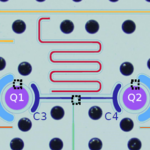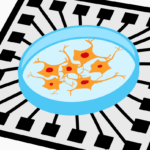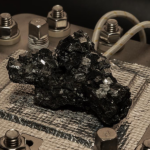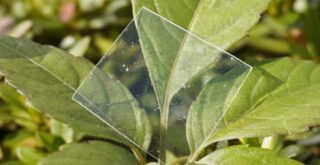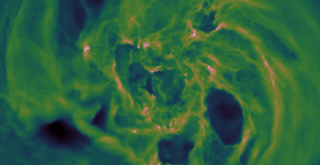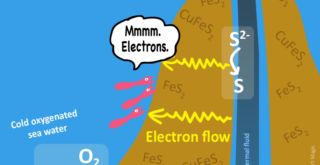Today I want to tell you about black smokers and electroecosystems. I recently wrote a news piece related to this topic, and what seems pretty sciencefictiony is now a big research topic. The oceans are just as good as outerspace.
Why black smokers?
We’re talking about black smokers because they’re where scientists think electroecosystems exist. Black smokers are a type of deep sea hydrothermal vent located in the ocean. When magma rises from the earth’s interior and meets cold sea water, tons of chemical reactions occur. The important point for us is that the [itg-tooltip tooltip-content=”<p>Hot water, usually heated by magma under the earth’s crust.</p>”]hydrothermal[/itg-tooltip] fluid spewing out into the ocean is full of [itg-glossary glossary-id=”2037″]reductive[/itg-glossary] chemicals. Some of these fall out from the liquid and form a chimney made mostly from pyrite (iron disulfide — FeS2) and chalcopyrite (copper iron disulfide — CuFeS2) around the vent. This is a great place for chemolithoautotrophic microbial communities to thrive because they live off the reduced material (sulfides, iron) coming up from the vent.
He said chemo-litho-what??
Well, let’s start with a word most people have heard: photosynthesis. In photosynthesis, green plants use light energy from the sun to turn carbon dioxide and water into sugar. The energy stored in the sugar can then be used as fuel by the plants. The sciency sounding word for plants that do this is [itg-tooltip tooltip-content=”<p>Photo = light, auto = self, troph = nourishment. So these guys gain nourishment by themselves using light energy</p>”]photoautotroph[/itg-tooltip]. But what about deep in the ocean where there is no sunlight? Life goes on! Chemoautotrophs are microorganisms like those living near the black smokers that use chemical energy to make their own fuel. Many are chemolithoautotrophs that synthesize their own sugars by oxidizing inorganic compounds.
What about the electroecosystem?
In 2010 a team of researchers at Tokyo University showed that the chimney walls of a black smoker can conduct electrical currents. They first used an electrode made from copper wire and a small section (3 cm3) from the inner wall of a chimney to examine oxidation of sulfide. This simulated the natural conditions in the black smoker: sulfides in the hydrothermal fluid flow up the inside of the chimney. They found that placing the electrode in salt water when sulfide ions were present (but not when they were absent) generated an [itg-tooltip tooltip-content=”<p>This means that electrons flow from ions in a solution into an electrode. </p>”]anodic[/itg-tooltip] current. So, electrons flowed from the sulfide ions into the electrode. And voilà, sulfide was oxidized into sulphur metal and an electric current flowed into the inner wall of the black smoker.
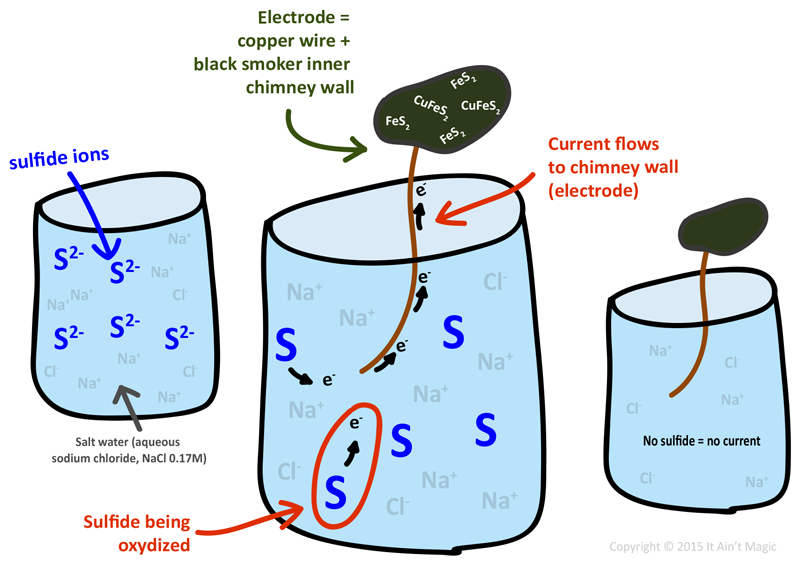
Simulating the conditions inside a black smoker chimney. An electrode made from copper wire and the inside of a black smoker chimney will draw electrons if sulfide ions are present. This oxidizes the sulfide, turning it into solid metal sulphur and sends a current into the chimney wall.
Next, they used an electrode made from the outer surface of the chimney to examine reduction of O2. This simulated the natural state outside the chimney because sea water is usually oxygenated—there is a surplus of dissolved oxygen that is released by photosynthetic plants in the water. Placing this electrode in an oxygenated environment generated a current ([itg-tooltip tooltip-content=”<p>This means that electrons flow from an electrode to ions in a solution</p>”]cathodic[/itg-tooltip] ) flowing from the electrode (the surface of the chimney wall) into the water. These electrons were picked up by the extra oxygen in the water, and voilà, free oxygen was reduced.
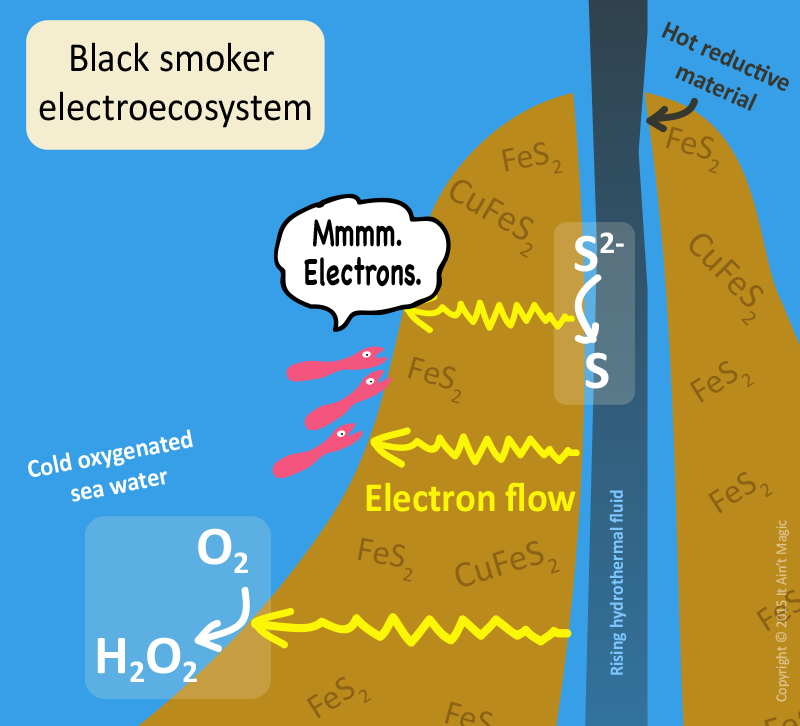
Hypothetical electroecosystem. Microorganisms live off the electric current flowing through the black smoker chimney.
So, a close-up of the black smoker ecosystem may look like this (if you ignore the unrealistically large and pink microorganisms).
The researchers hypothesized that some of the chemolithoautotrophs living off the inorganic material around the chimney might also be able to live directly off the electric current being conducted through the chimney wall. This is the basis for an electroecosytem in which the primary producers use energy from electric currents (not solar energy or chemical energy) to make the sugars that they need to survive.
Come back soon to see how Acidithiobacillus ferrooxidans, an iron eating bacteria, does just what was hypothesized!!
Nakamura, R., Takashima, T., Kato, S., Takai, K., Yamamoto, M., & Hashimoto, K. (2010). Electrical Current Generation across a Black Smoker Chimney Angewandte Chemie International Edition, 49 (42), 7692-7694 DOI: 10.1002/anie.201003311



